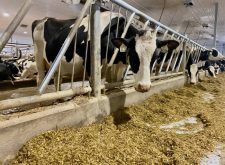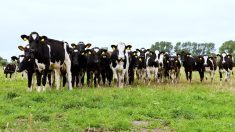Julie Van Rosendaal spent a lot of time last year thinking about butter.
And then she got a lot of people talking about it.
Last February, the Calgary-based cook and food writer found herself wondering why butter she was using was firmer than expected at room temperature and harder to spread.
“I started buying butter and poking it a lot,” Van Rosendaal said at the Alberta Forage Industry Network conference last month.
“I had these different butters all throughout my kitchen through the different seasons, poking them, spreading them, baking with them, and they were consistently a lot firmer than I recall.”
Read Also

Recommendations in the mature assets strategy could cause potential problems for landholders
The Western Stock Growers’ Association urges producers to pay attention to the potential changes to Alberta’s Mature Assets Strategy.
She was even rethinking how to list butter as an ingredient in a recipe.
“I usually say butter at room temperature — but then it wasn’t soft enough at room temperature to cream into cookies and cakes.”
But that same room temperature butter was perfect for making pies, which usually require chilled butter.
“It was sort of malleable. It didn’t have to be chilled — it was even better at room temperature,” she said. “I started to notice this, and people started to email me asking, ‘What’s up with butter?’ The conversation was happening everywhere.”
And then she tweeted about it — and the conversation really exploded.
“Something is up with our butter supply, and I’m going to get to the bottom of it,” Van Rosendaal tweeted on Feb. 5, 2021. “Have you noticed it’s no longer soft at room temperature?”
The response she got was overwhelming.
“People on social media were like, ‘I thought it was just me. I thought it was just cold in our house,’” she said. “And then it really took off. It travelled around the world really quickly. It shocked me how many news outlets around the world jumped on this, partly I think because all we had been talking about for the year before that was the pandemic.
“It kind of went viral. Jimmy Fallon joked about Canadian butter. It was crazy.”
Van Rosendaal attributes much of the ‘buttergate’ frenzy — not her term but one coined by a Twitter user as a hashtag — to the pandemic.
“People were baking more,” she said. “The demand for butter was up 12 per cent in 2021, so it was something everyone could relate to at home.”
Looking for the cause
Van Rosendaal then started looking for answers.
Processors told her they hadn’t changed anything, although some said “the milk that was coming in was so difficult to work with and they didn’t know what was going on,” she said.
Since firmness in dairy products is related to the ratio between saturated and unsaturated fats, a change in the fatty acid profile caused by a change in diet seemed to be “the obvious answer.”
“We know that feed has an effect on food,” she said. “We know that there are value-added products like omega-3 eggs because of the flax that’s fed to the laying hen.”
Then someone working in feed logistics mentioned to Van Rosendaal that certain feed supplements from overseas — like palm fats — were being impacted by supply chain disruptions.
In areas like New Zealand, West Africa, and the European Union, palm kernel expeller (a byproduct of the palm oil extraction process) is used as a common livestock feed source to boost output, as well as milk fat and butterfat content, she said.
“A lot of pastry chefs throughout this whole butter discussion said they only import their butter from New Zealand, which is the largest exporter of butter,” she said. “They like it because it’s nice and firm. The firmer butter does actually have some advantages if you’re a pastry chef.”
The opposite is true if you’re a cheese producer from the Netherlands though, she added.
“I found some Dutch cheese producers who were really concerned about their Gouda,” she said. “In the Netherlands, there was some action taken to reduce the palmitic acid supplements. They were seeing increased hardness in their cheese due to the palmitic acid supplements.”
Research done by David Christensen, a professor of animal science at the University of Saskatchewan, showed that feeding palmitic acid supplements increases the percentage of palmitic acid in the resulting milk by between 27 and 47 per cent, which increases the melting point of butter and affects the texture of cheese.
“He found that, if palmitic acid exceeded 32 per cent in the milk fat, then there was a noticeable change in the texture of the cheese,” said Van Rosendaal.
These supplements have been in use since the early 2000s, but she said formulations have changed and have more palmitic acid. (Palmitic acid is also found in other feed sources, like hay and silage, and is produced naturally in a cow’s milk.)
“About a decade ago, the supplements averaged about 50 per cent palmitic acid, and today, a lot of them are around 90 per cent and the rations are getting a little bit higher, typically about one to two per cent of dry ration,” she said.
A lesson to be learned
The ‘buttergate’ moniker “sensationalized” the issue, said Van Rosendaal.
“It comes across as scandalous or intentionally misleading, but (the supplements are) a tool just like any other thing,” she said.
Still, not many people understand the link between palmitic acid supplements and the quality of the final dairy product.
“It surprised me how many people didn’t know very much about the impacts of supplements, even though there is a ton of existing research on the palmitic acid transfer and the effects on the resulting butter,” she said.
“Despite all the research I had done, there was a lot of reaction saying that there was no proof.”
After Van Rosendaal’s tweet and the resulting tsunami of media coverage (including by the likes of the New York Times and BBC), the Dairy Farmers of Canada launched a working group to investigate the issue.
It also asked dairy farmers to consider alternatives to palm supplements in the interim, although even Van Rosendaal said it’s not easily replaceable.
“Palm fat is not going anywhere. Globally, palm is the No. 1 plant-based oil based both on production and consumption. It’s a very efficient crop. It’s the highest yield per hectare compared to crops like canola and soy. It has been increasingly popular in food production as we see an increase in plant-based products.”
In January, the working group released its final report, concluding that, despite the links between palmitic acid and texture in dairy products, last year’s issues with butter firmness could not be “solely attributed” to these palm oil supplements.
“After a careful review of the existing scientific literature and undertaking new testing and consultations with various industry and academic experts, we cannot conclude that any perceived increase in the hardness of butter be solely attributed to the use of palm-derived feed supplements,” said Daniel Lefebvre, chair of the working group. “There is a variety of factors that influence the fatty acid profile of milk which is only one of the factors that can affect butter consistency.
“We have also concluded there are gaps in the body of knowledge that should be addressed, and we offered a series of recommendations to better understand issues related to the properties of butter while also ensuring that industry is better equipped to meet consumer expectations.”
While ‘buttergate’ quickly faded from the headlines, there’s a lesson for all of agriculture on the need to be transparent with consumers, said Van Rosendaal.
“There’s such a disconnect between consumers and their food. They don’t understand what goes into getting a container of milk,” she said. “They hear these oversimplified stories in the media. There’s no nuance, and that’s where all the important stuff is.
“But people are paying attention. Right now, the onus is on consumers to do their own research if it’s important to them, but that’s changing.”















